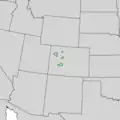| Crataegus saligna | |
|---|---|
 | |
| Scientific classification | |
| Kingdom: | Plantae |
| Clade: | Tracheophytes |
| Clade: | Angiosperms |
| Clade: | Eudicots |
| Clade: | Rosids |
| Order: | Rosales |
| Family: | Rosaceae |
| Genus: | Crataegus |
| Section: | Crataegus sect. Douglasia |
| Series: | Crataegus ser. Cerrones |
| Species: | C. saligna |
| Binomial name | |
| Crataegus saligna | |
 | |
| Natural range of Crataegus saligna | |
| Synonyms[1] | |
| |
Crataegus saligna is a species of hawthorn known by the common name willow hawthorn that is seldom cultivated and rather rare in the wild. Its native range is wet areas of western Colorado and northeastern Utah. It is a shrub or small tree with thin, elongated leaves, small flowers, small black fruit, and reddish bark.
It is related to C. erythropoda and C. rivularis.[1]
Images

 Natural range
Natural range
See also
References
External links
- Phipps, J.B.; O'Kennon, R.J.; Lance, R.W. (2003). Hawthorns and medlars. Cambridge, U.K.: Royal Horticultural Society. ISBN 0881925918.
- Beatty, B.L.; Jennings, W.F.; Rawlinson, R.C. (11 August 2004). "Crataegus saligna Greene (willow hawthorn): A technical conservation assessment" (PDF). USDA Forest Service, Rocky Mountain Region, Species Conservation Project.
This article is issued from Wikipedia. The text is licensed under Creative Commons - Attribution - Sharealike. Additional terms may apply for the media files.